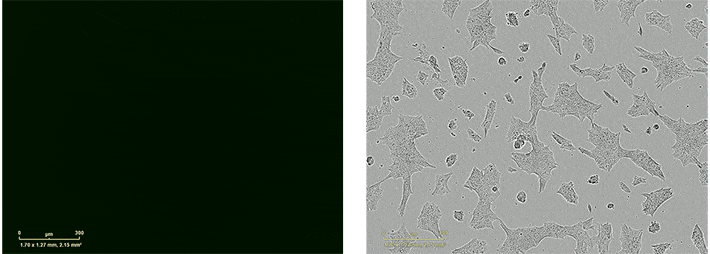Search Thermo Fisher Scientific
Lipofectamine 干细胞转染试剂
即使最难转染的干细胞实验,也具有极高的转染效率,并且无毒性
研究人员可在多能干细胞 (PSC) 和神经干细胞 (NSC) 中实现高达 80% 或更高的转染效率,在间充质干细胞 (MSC) 中实现高达 45% 的转染效率。
探索Lipofectamine干细胞转染试剂的优势:
- 通用: 可共递送 DNA(高达11 kb)、RNA 和 Cas9 蛋白质复合物
- 对细胞作用温和:在提供低毒性、持续细胞增殖的同时而不诱导分化
- 灵活:可转染贴壁和悬浮细胞,为电穿孔方法的简单替代方案

使用 Essential 8 培养基在玻连蛋白包被板上培养人 ES 细胞(H9),并用 1μL的 Lipofectamine Stem转染试剂转染GFP-表达构建体(500 ng总质粒DNA),得到定时相差(左)和荧光(右)影像。从转染开始观察培养物 48 小时。
Lipofectamine 3000试剂订购信息
应用资料:Lipofectamine 干细胞转染试剂的多功能性和性能
本研究旨在表明 Invitrogen Lipofectamine 干细胞转染试剂的多功能性。该转染试剂专为干细胞实验而开发,可以较高的转染效率同时递送较大的质粒结构和多种有效载荷。Lipofectamine 干细胞转染试剂可高效转染一系列干细胞类型,同时可在不诱导分化的前提下支持干细胞继续增殖。
对人胚胎干细胞 (ESC)、诱导多能干细胞 (iPSC)、神经干细胞 (NSC) 和间充质干细胞 (MSC) 具有卓越的转染效率
对于许多研究人员来说,干细胞转染是一项重要技术,但是干细胞的敏感性使得使用试剂进行转染的实验方案难以达到高效率。为了显著提高转染效率,Invitrogen Lipofectamine Stem转染试剂提供了一种简单、稳定、可重复的方法,将 DNA、RNA 和 RNP(如 Cas9 / gRNA 复合物)递送到广泛种类的干细胞中,包括多能干细胞、神经干细胞和间充质干细胞( 图 2 )。Lipofectamine 转染试剂系列的最新产品有助于在维持高效转染的同时,最大限度保持细胞存活并在未分化状态下生长。
具有将 DNA、RNA 和/或 Cas9 蛋白复合物递送至干细胞的通用性
基因编辑、基因表达和定向分化等研究应用的成败取决于将 DNA、RNA 和/或 Cas9 蛋白复合物递送至干细胞中的有效性和效率。涉及大构建体导入的实验通常使用电穿孔法,因为试剂转染的结果不佳。Lipofectamine Stem转染试剂具有广泛的干细胞转染功能,可转染最大 11 kb 的 DNA 质粒。
进行基因编辑时,Lipofectamine Stem转染试剂可共转染Cas9/gRNA 复合物以及单链 DNA,实现同源定向修复。此外,Lipofectamine Stem转染试剂可用于转染 mRNA 以用于使用干细胞的基因表达或定向分化研究。这些属性都使这种多功能试剂成为您的干细胞研究的理想补充。
A. DNA 递送
B. mRNA 递送
C. mRNA & Cas9 蛋白递送
图2.在多能干细胞转染过程中递送小型和大型 DNA 质粒、mRNA 和 Cas9 蛋白复合物时,Lipofectamine Stem转染试剂胜过 FuGENE HD 试剂。(A)根据随附实验方案使用 Lipofectamine Stem转染试剂或 FuGENE HD 试剂对人 ES (H9) 细胞或人 Episomal iPSC进行转染,递送 5kb 或 11kb 可表达 GFP 的 DNA 质粒,并在转染后24小时检测 GFP 表达。在下图中,使用 Lipofectamine Stem转染试剂对 NCRM-iPS 细胞进行转染,递送约 10.5 kb 的可表达 Cas9 和 GFP 的质粒,并通过免疫细胞化学进行检测。(B) 根据随附实验方案使用 Lipofectamine Stem转染试剂或 FuGENE HD 试剂对人 ES (H9) 细胞进行转染,递送可表达 GFP 的 mRNA。(C,左图)Lipofectamine Stem转染试剂可用于转染 Cas9 mRNA(修饰)/gRNA: Emx-1 crRNA (Exon2)-tracrRNA oligo/GFP mRNA(修饰)或 Cas9 蛋白/gRNA: Emx-1 crRNA (Exon2)-tracrRNA oligo/GFP mRNA(修饰)转染。(C,右图)使用 T7Endo 1 检测分析基因组修饰。
A. DNA 递送
B. mRNA & Cas9 蛋白递送
图3.在向神经干细胞递送小型和大型 DNA 质粒、mRNA 和 Cas9 蛋白复合物时,Lipofectamine Stem转染试剂胜过 FuGENE HD 试剂。(A,上图)根据随附实验方案使用 Lipofectamine Stem转染试剂或 FuGENE HD 试剂对人 iPSC 来源神经细胞进行转染,递送 5kb 可表达GFP的 DNA 质粒,并在转染后 24小 时检测 GFP 表达。(A,下图)根据实验方案使用 Lipofectamine Stem转染试剂对人 iPSC 来源神经细胞进行转染,递送 11kb 可表达GFP的 DNA质 粒,并在转染后 24小 时检测GFP表达。(B,左图)悬浮培养的人 iPSC 源神经干细胞采用 Lipofectamine Stem转染试剂递送 250 ng Cas9 mRNA(修饰)/ gRNA: Emx-1 crRNA (Exon2)-tracrRNA oligo/GFP mRNA(修饰)或 Cas9 蛋白/gRNA: Emx-1 crRNA (Exon2)-tracrRNA oligo/GFP mRNA(修饰)转染。24 小时后观测 GFP 的表达情况。(B,右图)使用 T7Endo 1 检测分析基因组修饰。
A. DNA 递送
B. mRNA 递送
图4.在向间充质干细胞内递送质粒 DNA 和 mRNA 时,Lipofectamine Stem转染试剂胜过 FuGENE HD 试剂。( A,上图) 根据随附实验方案使用 Lipofectamine Stem转染试剂或 FuGENE HD 试剂对 StemPro 人脂肪来源干细胞进行转染,递送 5kb 可表达 GFP 的 DNA 质粒,并在转染后 24小 时检测GFP表达。( A,下图) 根据随附实验方案使用 Lipofectamine Stem转染试剂或 FuGENE HD 试剂对 StemPro BM 间充质干细胞进行转染,递送 5kb 可表达 GFP 的 DNA 质粒,并在转染后 24小 时检测 GFP 表达。(B) 使用 Lipofectamine Stem转染试剂转染 StemPro BM 间充质干细胞 递送可表达 GFP 的 mRNA ,并在转染后 24小 时检测 GFP 表达。
A. DNA 递送
B. mRNA 递送
C. mRNA & Cas9 蛋白递送
图2.在多能干细胞转染过程中递送小型和大型 DNA 质粒、mRNA 和 Cas9 蛋白复合物时,Lipofectamine Stem转染试剂胜过 FuGENE HD 试剂。(A)根据随附实验方案使用 Lipofectamine Stem转染试剂或 FuGENE HD 试剂对人 ES (H9) 细胞或人 Episomal iPSC进行转染,递送 5kb 或 11kb 可表达 GFP 的 DNA 质粒,并在转染后24小时检测 GFP 表达。在下图中,使用 Lipofectamine Stem转染试剂对 NCRM-iPS 细胞进行转染,递送约 10.5 kb 的可表达 Cas9 和 GFP 的质粒,并通过免疫细胞化学进行检测。(B) 根据随附实验方案使用 Lipofectamine Stem转染试剂或 FuGENE HD 试剂对人 ES (H9) 细胞进行转染,递送可表达 GFP 的 mRNA。(C,左图)Lipofectamine Stem转染试剂可用于转染 Cas9 mRNA(修饰)/gRNA: Emx-1 crRNA (Exon2)-tracrRNA oligo/GFP mRNA(修饰)或 Cas9 蛋白/gRNA: Emx-1 crRNA (Exon2)-tracrRNA oligo/GFP mRNA(修饰)转染。(C,右图)使用 T7Endo 1 检测分析基因组修饰。
A. DNA 递送
B. mRNA & Cas9 蛋白递送
图3.在向神经干细胞递送小型和大型 DNA 质粒、mRNA 和 Cas9 蛋白复合物时,Lipofectamine Stem转染试剂胜过 FuGENE HD 试剂。(A,上图)根据随附实验方案使用 Lipofectamine Stem转染试剂或 FuGENE HD 试剂对人 iPSC 来源神经细胞进行转染,递送 5kb 可表达GFP的 DNA 质粒,并在转染后 24小 时检测 GFP 表达。(A,下图)根据实验方案使用 Lipofectamine Stem转染试剂对人 iPSC 来源神经细胞进行转染,递送 11kb 可表达GFP的 DNA质 粒,并在转染后 24小 时检测GFP表达。(B,左图)悬浮培养的人 iPSC 源神经干细胞采用 Lipofectamine Stem转染试剂递送 250 ng Cas9 mRNA(修饰)/ gRNA: Emx-1 crRNA (Exon2)-tracrRNA oligo/GFP mRNA(修饰)或 Cas9 蛋白/gRNA: Emx-1 crRNA (Exon2)-tracrRNA oligo/GFP mRNA(修饰)转染。24 小时后观测 GFP 的表达情况。(B,右图)使用 T7Endo 1 检测分析基因组修饰。
A. DNA 递送
B. mRNA 递送
图4.在向间充质干细胞内递送质粒 DNA 和 mRNA 时,Lipofectamine Stem转染试剂胜过 FuGENE HD 试剂。( A,上图) 根据随附实验方案使用 Lipofectamine Stem转染试剂或 FuGENE HD 试剂对 StemPro 人脂肪来源干细胞进行转染,递送 5kb 可表达 GFP 的 DNA 质粒,并在转染后 24小 时检测GFP表达。( A,下图) 根据随附实验方案使用 Lipofectamine Stem转染试剂或 FuGENE HD 试剂对 StemPro BM 间充质干细胞进行转染,递送 5kb 可表达 GFP 的 DNA 质粒,并在转染后 24小 时检测 GFP 表达。(B) 使用 Lipofectamine Stem转染试剂转染 StemPro BM 间充质干细胞 递送可表达 GFP 的 mRNA ,并在转染后 24小 时检测 GFP 表达。
Lipofectamine Stem转染试剂可实现健康培养,不会诱导分化
转染干细胞时,确保培养条件可支持细胞在未分化状态下持续增殖非常重要。虽然外源性构建体的引入可能产生预期内和意外的结果,但是 Lipofectamine Stem转染试剂对增殖没有不利影响(图 5)。

图 5.转染细胞继续以与未转染细胞相似的速率增殖。通过对转染和未转染的 iPSC 进行融合度测量,观察到相似的生长速率和汇合时间。
提高贴壁和悬浮PSC转染效率的技术提示
多能干细胞的培养系统有许多选择,包括使用滋养层的培养体系和使用基质代替滋养层的无滋养层培养体系。Lipofectamine Stem转染试剂可与各种培养系统结合使用。以下是在您所选培养系统中提高转染效率的一些提示:
- 对于 PSCs 作为细胞团簇传代并在滋养层或 Geltrex 基质上作为大克隆生长的培养条件,在传代和重新接种时对悬浮细胞进行转染可使试剂最大程度地接触到所有细胞,提高转染效率。这种方法可用于单层培养以确保高转染效率,也可作为电穿孔的替代方法。
- 当转染于Geltrex 或 Matrigel 基质上生长的贴壁细胞时,应确保以 30-60% 的最佳密度将小团簇或单个的多能干细胞接种,使其在转染后24 至 48 小时的时间内可以继续扩增。
- 当转染贴壁培养物时,可在玻连蛋白或层粘连蛋白上培养细胞,使细胞扩增出更多的单层,从而提高转染效率。
- 尽管Lipofectamine Stem转染试剂可兼容大多数培养系统,但某些干细胞培养基中的成分可能会干扰脂质体转染。在这些情况下,在转染实验开始最初的1-4小时使用 Opti-MEM 培养基,然后再添加您选用的培养基,可以最大限度地减少这种干扰,同时细胞仍然能够持续扩增。有关具体细节,请参阅 Lipofectamine Stem 转染试剂用户指南。
干细胞专用实验方案
除了为 Lipofectamine Stem 转染试剂用户指南开发的实验方案,我们还制定了经过优化的干细胞专用实验方案,这将有助于指导您使用各种干细胞类型(iPSC、ESC、NSC)和培养基实现低毒性的高效转染。该实验方案涵盖细胞生长、培养条件、传代以及获得成功的转染结果。
我们的 Lipofectamine 试剂特异性方案针对多种细胞类型在效率、活率和可重复性方面进行了优化。搜索该数据库,找到满足您实验需求的方案和参考文献。按细胞类型、递送物质和选择的产品进行筛选,可以轻松找到您需要的答案。
教育和工具
相关应用
相关支持
转染常见问题
搜索我们广泛的转染常见问题解答集合,以找到与Lipofectamine LTX与PLUS试剂相关的答案。
仅供科研使用,不可用于诊断目的。
















